Rochelle Yang started marathon training two years ago, working her runs into her hectic schedule as a full-time pharmacy student at the University of Iowa. She trained year-round, putting up with snow, sleet, and regular sub-freezing temperatures. Sometimes, it was hard fitting in runs into her day. After a 12-hour day of classes, studying, and working a part-time job, she'd get home at 7 PM, have a quick snack, and then bang out somewhere between 7 and 13 miles, sometimes on less than 5 hours of sleep.
"I'll be honest," Yang wrote to me via email, "there were many days I hated running" (although she did add a smiley to the end of that sentence).
She dreamed of running in the Boston Marathon someday, but didn't think she'd hit the qualifying time in the near future. Her goal for the first marathon she ran, in June 2015, was simply to finish without stopping or walking. She finished in 3 hours 50 minutes, only 15 minutes shy of hitting the Boston qualifier time, commonly referred to as "BQ." For the next four months, she trained hard trying to shave those 15 minutes off her time.
At the IMT Des Moines Marathon in October 2015, Yang pushed herself, particularly in the last four miles, to hit BQ, which is 3 hours 35 minutes for her age group. "I remember thinking I would be okay with everything in my life going wrong for the next year if I could just beat the 3:35 pacer to the finish."
Yang crossed the finish line, exhausted and numb. Once she regained a modicum of wind, Yang called her parents, fighting to catch her breath and holding back tears at the same time, which, she remembers, made her sound like she was injured. Her parents asked if they needed to call an ambulance. Finally, she got the words out so they could understand.
Read more on VICE Sports
To Catch a Marathon Cheat
A Toronto Bar Owner Has Been Charged With Gang Sex Assault After Allegedly Trapping A Woman Inside
The owner of College Street Bar in Toronto and one of the bar's employees have been charged with gang sexual assault after a woman was allegedly locked inside and sexually assaulted in December.
Owner Gavin MacMillan, 41, and Enzo De Jesus Carrasco, 31 have both been charged with four counts of gang sexual assault; forcible confinement; and trafficking a schedule 1 substance. Dejesus has been charged with an additional three counts of sexual assault while MacMillan has been charged with fail to comply with recognizance.
The men appeared in court Tuesday.
Toronto police say the 24-year-old victim was given illicit drugs and alcohol at the bar and was forcibly confined inside where she was sexually assaulted, from the evening of Dec. 14 into the next morning.
The Sexual Assault Action Coalition, an advocacy group, said on Facebook that it has been in contact with the city and the Ministry of Labour to shut down the bar "until after these two monsters face trial.
"THERE IS NO ROOM FOR SILENCE AND COMPLACENCY!" the group posted.
The bar's website said it is open Thursdays through Sundays. A spokesman for the bar told BlogTO the establishment "has proven to be resilient in these times and is grateful to those patrons who keep walking into our doors."
Follow Manisha Krishnan on Twitter.
How Kendrick Lamar's 'To Pimp a Butterfly' Artwork Is the Lasting Document of America's Hip-Hop President
Imagery has always been an instrumental narrative to Kendrick Lamar's music. Whether it's his mother's van that houses the tales of his youth in Compton on the cover of good kid m.A.A.d City or the picture of a mother breastfeeding her children as a way to discuss the origins of African-Americans in "The Blacker the Berry," there's a visual commentary that hints to a major theme in his music. Similarly, To Pimp a Butterfly's album artwork encapsulates the album's frank discussions on race, self-love/hate, and most of all, to be black in America. But in recent times, in much the same way The Roots did with Things Fall Apart and its depiction of humanity's failure in the civil rights era or Green Day's American Idiot symbolism of post 9/11 turmoil, TPAB's cover has come to be one of the most powerful and representative pieces of iconography of the Obama era.
The photo—taken by famed photographer Denis Rouvre under the direction of Kendrick Lamar and TDE CEO Dave Free (otherwise known as visual duo The Little Homies) and Vlad Sepetov—depicts a group of primarily black men and children in a celebratory display in front of the White House, with the rapper in the center holding a child. At their feet lies a white judge with his eyes crossed out, the presumption being that he's dead. According to Lamar, the photo represents, "just taking a group of the homies who haven't seen the world and putting them in these places that they haven't necessarily seen, or only on TV and showing them something different other than the neighbourhood and them being excited about it. That's why they have them wild faces on there." In another sense, the image represents the long-traveled road of bringing your kin up to that front lawn and the joyful exhale of closing the gap between literal black and white. And it's in this way TPAB cover art also symbolizes Obama's invitation of hip-hop and, by proxy, blackness into the White House.
Read more on Noisey
'Pillbug's Tea Time,' Today's Comic by Allison Conway
How Trump's Anti-Muslim Immigration Crackdown Will Test Canada's Acceptance of Refugees
It has been less than week since his inauguration, and President Donald Trump has wasted no time signing a smorgasbord of controversial executive orders: rolling back Obamacare, killing federal aid for any NGO that even mentions "abortion" in their policies, pulling the US out of the TPP, and approving the Keystone XL and the Dakota Access Pipeline (DAPL).
Today, however, just three working days into his new job, he is set to sign a swath of orders relating to his most acidic and xenophobic campaign promises: banning travelers from countries with high populations of Muslim citizens, enforcing an aggressive deportation strategy, and, of course, kickstarting the construction of his infamous Mexican border wall (which he claims Mexico will pay for).
Contrary to popular belief, immigration policies in the US don't only affect Americans. Earlier this month, a pair of Ghanian refugees, ordered to be deported back to Ghana by US authorities, barely survived a perilous trek across the Canadian border near Emerson, Manitoba.

Seidu Mohammad and Razak Iyal walked to Canada in -18 weather after their asylum requests were denied in the US. Photo by Caroline Wintoniw/VICE News
The two men men, after trudging through waist-high snow for several hours in sub-zero temperatures, sustained serious damage due to exposure to the elements. One of the men, Seidu Mohammad—afraid his sexual orientation would result in execution upon deportation to Ghana—is now expected to lose both his fingers and toes to frostbite.
"These are troubling times," Raj Sharma, a high-profile immigration lawyer located in Calgary, Alberta, told VICE Wednesday. "There's going to be a lot of deportations. We should get ready to see many, many more [similar] cases to the one we saw in Manitoba."
Sharma says that there are a number of major concerns in terms of how Canada will handle an influx in refugees, but he notes that the Safe Third Countries Agreement (STCA)—part of the US-Canada Smart Border Action Plan—will be one of the biggest obstacles for those who are fleeing from the US, regardless of what that reason may be.
The STCA, drafted shortly after 9/11, prevents anyone traveling from the US from seeking refugee status in Canada at border crossings and airports. This is done by making it so that a refugee claimant must seek refugee status in their "first safe country."
Effectively, this means that anyone fleeing from the US—whether that be undocumented immigrants under the threat of deportation, or Muslim Americans who fear for their safety—would first need to find a way to get into Canada illegally (and, like the case of the Ghanaian men earlier this month, likely dangerously.)
On Wednesday, Stats Canada published a new study that found almost half of Canada's population is expected to be immigrants by the year 2036—a number that hasn't been as high since 1871. It also noted that most working-age Canadians will be of a visible minority, jumping from under 20 percent in 2011 to 40 percent in 2036.
Saima Jamal, co-founder the Syrian Refugee Support Group in Calgary, says that Trump's move to become more aggressive on immigration is so surprise to those arriving here. Citing the story of one Syrian man she worked to resettle recently, Jamal says many refugees are choosing Canada or death—mostly due to fear of an increased nationalist sentiment coming out of places like the US and Western Europe.
"This man, with three little, little children, was told he could go to Germany in three days. He said no, and waited six months to come to Canada, because of what we offer here, because he didn't want to live in fear," Jamal told VICE Wednesday.
Both Jamal and Sharma agree that, going forward, the long-held notion of Canadian acceptance of immigrants will be tested as more and more refugee claims come from countries like Iran and Iraq, which are on the list of countries that Trump's travel ban will affect.
In Canada, politicians like Conservative leadership candidate Kellie Leitch have already proposed a "values test," which many have criticized as xenophobic and which Sharma jokes is just a "brown person polygraph." Jamal argues how dangerous this is, and told VICE that there needs to be increased pressure on the Canadian government to find ways that will allow US refugees to apply for asylum without forcing them to risk their safety via dangerous, DIY border crossings.
"I cannot fathom it's 2017 and that we have arrived at such a point…We need to be prepared to make the border crossing process for those seeking asylum a humane process. We cannot let our belief in people from other places falter."
Sharma also says that he expects a lot of IT companies to begin setting up satellite offices in Canada if the Trump administration goes through with a crackdown on the H1Bs. Sharma says that a visa chokehold, coupled with restricted immigration from Middle Eastern countries, will "seriously" skew the number of skilled workers applying to Canada versus the US.
Regardless of the economics or social reaction, the ultimate problem with all of these policies will fall on whether those applying for refugee status can make a claim that shows "personalized risk," Sharma tells me.
"This is actually very similar to what happened after September 11th, 2001," Sharma told VICE, describing his time as a Canadian refugee protection officer from 2002 to 2004. "There was about 30,000 Pakistani folk basically emptied from [urban centres] and began applying for claims in Canada."
"A lot of these kids—[students] for the most part—couldn't go back to Pakistan. You know, they were born there and grew up in the US, their Urdu was shit, but that's not a great argument for a claim. So, yeah, we could have people fleeing [the US] in large numbers, and immigration officials might have to start denying them because it's not what many see as dangerous."
Follow Jake Kivanc on Twitter.
Searching for Compassion at Sundance
The unofficial theme of this year's Sundance has been What are we doing here and does any of this matter anymore? and it isn't surprising that a common response to these questions and to the political activism happening this week is a sort of self-implicating cynicism. In between screenings, iPhones light up as people check in with the latest Trump news and then share knowing glances that seem to say: Yep, here we are, watching movies on a mountain while the world burns below.
And the setting for Sundance isn't helping anything. The theater shuttle loops riders past the Park City Cemetery, where heavy snowfall outlines the unmarked graves of miners and their families, reminding us of Park City's long-gone working-class origins. Passing through Old Town, my friend Iris, a local, pointed out rows of houses that used to belong to the miners and told me that 30 years ago you could buy one for $15,000, but now the cost for these small, quaint homes averages at $2 million. She nodded up to the ski resorts and mansions perched above on the surrounding mountaintops and said, "Now Park City is just a safe place for rich, white men to express themselves."
On Saturday, I attended Park City's Women's March on Main, which featured speeches from Chelsea Handler, Jessica Williams, Connie Britton, and others. As I listened, I tried to be moved toward either hope or anger, as either seemed more appropriate than the undefined sadness I actually felt. Another journalist standing nearby read my scowl and said, "Cute, isn't it?" and rolled her eyes. "I can't believe I'm here and not in Washington." I roamed the edges of the march reading signs, but the more I saw, the less sure I was of what I should be feeling.
Clarity came, unexpectedly, that night at a screening for Macon Blair's directorial debut, I Don't Feel at Home in This World Anymore, which stars Melanie Lynskey as Ruth, a quiet, kind-heartened nurse who really just wants people to be a little nicer to one other. The film introduces us to Ruth through her muted reactions to other people's carelessness: She picks up after a shopper who drops food in the aisles of the grocery store and is rewarded by being cut in line at checkout; in the parking lot, she dodges a car that backs into her path without looking. Blair himself makes a cameo as a man who strikes up conversation with Ruth at a bar, interrupting her while she's reading. Instead of being annoyed with the intrusion, Ruth reveals her hunger for human connection by eagerly engaging until he ruins the ending of her book and walks away.
I Don't Feel at Home's plot centers on a burglary of Ruth's home, but the film's emotional weight rests in the smaller, everyday slights. After the break-in, Ruth seeks comfort at her best friend's house, only to receive politely dismissive reactions to her trauma. In the best scene of the film, Ruth tells her neighbor Tony (Elijah Wood)—who has an epic rattail and a ninja-throwing star collection—about her break-in, and he responds by whipping nunchucks into a table, thus expressing the rage she's kept bottled. His acknowledgement of her frustration emboldens her and sets them both on a path of righteous revenge that is equal parts funny, violent, and suspenseful, earning Blair apt comparisons to the Coen brothers. But Blair's promise as a filmmaker and writer shines most brightly in the way he handles the film's smallest moments. He brings the same level of dramatic tension to the climatic showdown with the big bad Marshall (played by the Jesus Lizard frontman David Yow), as he does to an earlier scene where Ruth, through gritted teeth, says, "Why do people have to be assholes?"
Watching Melanie Lynskey try to contain her despair while being denied the simplest considerations brought into focus the feeling I had walking around the morning's march, taking in the surreal modesty of the requests made in speeches and written on signs. Overwhelmingly, all anyone was asking for was kindness, inclusiveness, and to not suffer diminished rights due to their gender, skin color, or sexual orientation. These requests felt unlikely to be taken seriously by an administration that, so far, excels at nothing more than the fervent denial of the reality of its dissenters. In light of this, the bond between Tony and Ruth, who have nothing in common other than a willingness to take each other seriously, struck me as especially cathartic and profound.
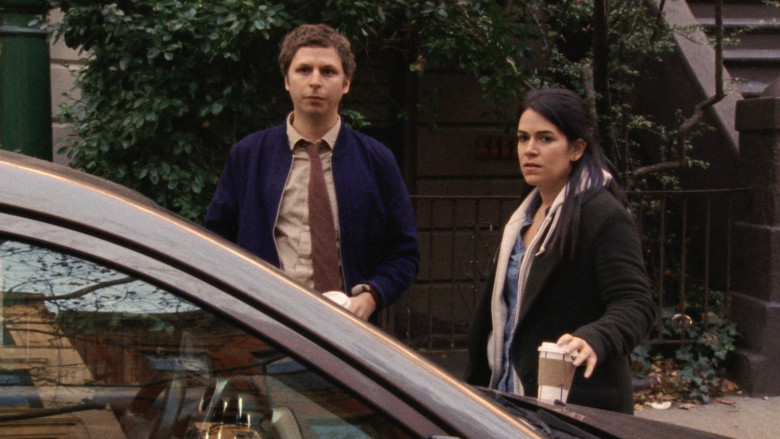
Michael Cera and Abbi Jacobson in 'Person to Person.' Courtesy of the Sundance Institute
This theme continued at that night's screening of Dustin Guy Defa's Person to Person, which follows several storylines played out in a single day in New York City and is led by actors Bene Coopersmith, Tavi Gevinson, Michael Cera, Abbi Jacobson, and Phillip Baker Hall. Defa, who also wrote the screenplay, was coaxed into taking the stage to introduce the film, his feature-length debut, which he did, shyly, saying only, "This film is about tenderness, friendship, and the desire to connect." The storylines are tied together by each character's asking for some small request—to share a meal, to not be forced to socialize, to avoid confrontation, to not be ripped off, to get an honest opinion on a shirt—most of which go unfulfilled. The most representative moment comes when Michael Cera (in a scene that will either make you sad or cringe with embarrassment depending on your level of cynicism) slumps his head down on a desk and asks Abbi Jacobson if she'd just please have a drink with him. When she refuses, he asks, "Why is it so hard to get people to like me?"
There's a good chance that, had I seen the film months ago, I wouldn't have liked it much, nor thought it had enough to say, but as I sat in the Egyptian Theater, exhausted from months of Trump's skillful gaslighting, I decided that watching a film that explored the sheer frustration of having a reasonable request denied was not, at minimum, a meaningless endeavor.
Follow Chloe Cooper Jones on Twitter.
The 'Sweet/Vicious' Finale Shows How Title IX Can Fail Survivors
MTV's Sweet/Vicious kicked off an ambitious first season by confronting the realities of sexual assault on college campuses—through radical honesty, dark humor, and a healthy dose of vigilante justice doled out by two young women. The series started off strong and, over the course of ten episodes, grew even better by balancing a revenge story that was often told through brutal violence with a survivor's intimate story of navigating the aftereffects of her own rape and dealing with an administration that failed her.
The double-episode season finale, which aired last night, brought together multiple storylines that had been floating around all season, from Harris finding out about Ophelia's vigilante moonlighting to the cops arresting a (false) suspect for the accidental murder that occurred in the pilot. The strongest—and most affecting—storyline has always been Jules's reactions to her rape, which occurred before the series began but which lingers throughout every episode. It's especially persistent because her rapist, Nate, is a golden boy on campus—who also dates Jules's best friend and sorority sister, Kennedy.
The seventh episode, "Heartbreakers," provided viewers with an extended flashback to the fraternity party (it begins with a disclaimer warning that the episode will feature a sexual assault scene; it's not the only episode to start this way) and Jules's immediate reactions. In one telling scene, we see her start to search the internet for answers. At first, she begins to type "how do you know if you've been"—but then stops before completing the question. Instead, she decides on "someone had sex with me when I didn't want them to." It's a small moment, but it's weighty, revealing how Jules is hesitant—scared—to just type the word "rape" into her computer. It speaks volumes to how taboo that word still is, how so many women were raised to never talk about rape—even when it happens to them.
The episode also shows that Jules did go to the administration, but the Title IX counselor—a woman—gently discourages Jules from pursuing the case. She asks how much Jules was drinking, tells her that it sounds like it "was just a mistake." She even mentions that Nate is one of the college's most high-profile students and warns that if Jules goes forward, people will start going into her personal business and combing through her Facebook profile. The counselor basically lets Jules know that she can't trust the school to do something. Here, the series hammers home exactly why Jules started going over other men accused of sexual assault on campus: Jules knows that she can't prosecute her own rapist.
The failure of this administration—and the realities of being a known survivor on campus—are further depicted in the ninth episode, "An Innocent Man." Jules, newly emboldened after Kennedy learns of everything that happened, decides to officially report the rape to the Title IX office. From there, we see how poorly these situations can be handled: The Title IX counselors repeatedly ask students about alcohol, about drugs, about whether or not Jules went to the party with intentions to have sex. They strongly imply that maybe it's Jules's friends' fault for not doing more to take her home—anything to get the blame away from Nate. At one point, referring to a picture of Jules at the "Hos and CEOS"-themed party, a counselor quips, "I haven't met many CEOs dressed like that!"
It's frustrating, particularly when it begins to combine Jules and Nate's conflicting testimonies. While Jules says that she "could barely stand," Nate concedes, "She was a little drunk, sure." Jules said she explicitly told Nate "no." Nate claims she was moaning and saying his name. And the whole time, while Jules tries to remain strong, Nate's demeanor is more exasperated, as if he's annoyed something so small is taking up his time. It's a rough scene because it mirrors so many real survivors' accounts—the creator and showrunner did their research, according to interviews with BuzzFeed, where they read Missoula, spoke with Title IX coordinators, talked to survivors, among other things. For a second, there's a brief flurry of hope—Nate is found guilty. But it disappears just as quickly as it arrives: The university president overturns the verdict, without even hearing Jules's account. Once again, Jules has to find a way to help herself, because her school won't.
Throughout this stellar first season, Sweet/Vicious didn't back away from any plot: One episode centered on an Uber-like driver assaulting drunk passengers; the finale touched on how wealthy families can buy someone's innocence; we witness the reaction of Nate's fans, who thinks Jules is trying to ruin his life ("I'd love to get raped by Nate," says one clueless student, while Jules is in earshot); one twist showed 26 assault cases that were dismissed or mishandled by the DA's office—setting up a new plot for the second season, should MTV renew it.
And MTV should renew the series. Sweet/Vicious slowly became one of the best shows on television dedicated to portraying and dissecting sexual assault. It's clear that Sweet/Vicious doesn't want to use rape as a dramatic and traumatic plot device, like so many other shows. It wants to pick apart everything associated with it, right down to how often campus and law officials fail survivors. It's a show that provides a rare in-depth look into sexual assault, but a necessary one.
Follow Pilot Viruet on Twitter.
Man with Bionic Penis Must Endure Two-Week Erection to Finally Use It
Andrew Wardle has been a virgin his entire life, but it's not because he hasn't had luck with the ladies. The 44-year-old UK resident has had a girlfriend for four years, but the two have never had sex because Wardle was born without a penis due to a rare medical condition.
Now, after sharing his story on the TLC documentary, The Man with No Penis, and undergoing more than 100 surgeries, Wardle is set to finally get laid thanks to his new "bionic penis."
As a baby, Wardle received corrective surgery for his ectopic bladder, which formed outside of his body, but the operation prevented him from ever developing a penis. He thought he would have to endure life without one until Mohammad Abad, a British man who lost his penis in a childhood accident, had the experimental technology installed in 2012.
Like Abad's, Wardle's new penis was created using skin, muscle, and nerve grafts from his arms and fitted with cylinders that fill with fluid when pumped from a small sac installed in his ball sac, which is how he'll get an erection. However, doctors will have to go in and essentially turn the rig on, a process that will leave Wardle in the hospital for three days and give him an boner that will last two long weeks.
On Wednesday, Wardle told the hosts of British television show This Morning that he'll spend those two weeks inside so as not to show the world the rocket that will be in his pocket. Speaking of which, he also told the hosts he did not get to select the size of his new member, which seems like a major oversight in the way bionic phalluses are constructed.
Once the robo-cock is switched on and his two-week erection dies down, Wardle will be able to have sex with his girlfriend, Fedra Fabian, for the first time. She revealed on the show that the two had been dating for nine months before she found out about his condition and she read about it in the newspaper. "I didn't know how to react to it," she said.
For a man who is about to finally lose his virginity after four decades, you would think Wardle would be a peaceful guy, but he's already started a feud another dude who also has a pneumatic dick. Wardle had some harsh words for Abad, who lost his virginity to a famous sex worker and said recently that he wants to date a sex robot.
"This is a taxpayer-funded operation—the money spent on it was not so he could sleep with a prostitute," Wardle said Friday.
Yes, that's right, the National Health Service paid for both operations, making it entirely free. Americans live in a country where healthcare premiums cost an arm and a leg. Over in the UK, they're just handing out bionic dongs for free so that middle-aged men don't have to be virgins anymore. How can we get on that health plan?
College Kids Want Free Tampons for America
When Brown University's student government started stocking campus bathrooms with free tampons and pads at the start of this school year, people were thrilled.
"We had seen a lot of momentum and wonderful progress on this issue on the state level and in secondary education, with states eliminating their tampon taxes and New York City public schools providing the products as well," Viet Nguyen, Brown's undergraduate student body president, told me. "While there was chatter in the higher ed sphere, there wasn't as much tangible action. We wanted to tip the dominoes."
Now, you can find tampons and pads in about half of bathrooms on campus—and not only in women's bathrooms, but in men's and gender-neutral bathrooms as well. The idea is spreading fast: According to Nguyen, more than 40 universities across the world—including Cornell, Syracuse, and Connecticut College—have reached out to Brown and started jumpstarting their own programs.
The movement to make menstrual supplies more accessible on college campuses is led largely by student governments, but it's inspired by an international effort to end the stigma surrounding menstruation. At the forefront of this effort are campaigns to end the "tampon tax"—the practice in many states of taxing tampons, pads, and other menstrual products as non-essential items, while counting items like contact lenses, lip balm, and even Rogaine as necessities.
In 2015, Canada became the first country to get rid of a tampon tax after a petition garnered nearly 75,000 signatures and pushed the government to act after years of debate.The move spurred the UK and Australia to consider similar measures, and also increased momentum in the United States. At the time, 40 US states taxed tampons. Since then, New York, Illinois, Connecticut, and Washington, DC, have eliminated taxes on tampons, with similar measures pending in several other states.
Taxes aside, tampons and pads represent a real expense for the people who need them. California state assemblywoman Cristina Garcia estimated that Californians who menstruate spend an average of $7 per month on supplies, or $84 per year. Over a lifetime, that's an extra $3,360 spent just on sanitary supplies. Newer, reusable alternatives like menstrual cups and period underwear can be cheaper in the long run, but are expensive upfront—reusable cups retail for $15 to $40 apiece, and period underwear run about $24 to $38 a pair. For a low-income individual or household, these can be significant expenses. Food stamps do not cover sanitary supplies, and some low-income women have reported trading food stamps for tampons.
In addition to aiding low-income students, many student leaders argue that tampons and pads are as much a bathroom necessity as toilet paper and hand soap. "From an equity standpoint, if you use tampons and pads, right now you don't have everything you need in most public bathrooms," said Abigail Porter, a senior at Columbia University and vice president for policy of the Columbia College Student Council.
In a survey conducted by advocacy organization Free the Tampons, 86 percent of respondents reported having at least one experience when their period arrived unexpectedly in public and they were without the supplies they needed. This is no surprise to anyone who menstruates: Even the most regular periods can come early or be heavier than expected, leading to a scramble to find supplies. Only 8 percent of survey respondents reported that tampon and pad dispensers in public bathrooms work all the time, a wholly unsurprising fact to anyone who has ever been in a public women's bathroom. On the off chance a dispenser is working, it usually requires quarters, meaning that you are still out of luck unless you have a quarter with you in your moment of need. Plus, these dispensers are usually located in women's bathrooms only, leaving transgender men without access to them.
Brown's program may have inspired other campuses to provide free tampons, but it wasn't the first college to come up with the idea: The University of Nebraska-Lincoln has provided free tampons in women's and gender-neutral bathrooms since 2015, and the University of Minnesota has provided free menstrual supplies on campus for at least a decade, stocking one women's bathroom per building. The University of Minnesota also started stocking gender-neutral bathrooms last year, inspired by the inclusivity of Brown's program.
At Columbia, a new pilot program is starting this month, modeled from Brown's, to provide tampons and pads in men's, women's, and gender-neutral bathrooms. An earlier version of the program, which debuted in spring 2016, provided free tampons and pads in just one location, at the campus Health Services clinic. The program was cancelled due to lack of interest—"Columbia ditches free tampons because nobody actually used them," proclaimed a gleeful Daily Caller—but reinstated after student outcry.
"Last year, the program started in the middle of the semester, without much advertising, and just in one location," Porter said. "But when it was suspended, we heard from a lot of people who wanted the program to continue. We're looking forward to a new program and having the products in bathrooms." She also told me there was an accessibility issue with the original plan. Columbia's campus is uneven and has many stairs, which is already a problem for students with disabilities. Having tampons and pads in only one location meant that disabled students may not have been able to reach them conveniently. The university offered to foot the bill for dispensers, but members of the student government will stock them.
At Emory University, the administration was convinced to fund and manage a pilot program after it asked student-government representatives to gauge student interest. Julie Chen, then an Emory College council sophomore legislator and now assistant vice president of finance, set up a petition and shared it on her personal Facebook page. "Within a few days, it had 900 responses," she said. The pilot program, which operates in only four locations, began in fall 2016. After a successful initial run, the university agreed to extend it for two years, after which students hope it will remain and expand.
"Providing these products is a huge movement, especially in the North," said Emory College Council President Molly Zhu. "One thing we really hope to do is bring this progressive feminist movement to the South."
Zhu may be getting her wish already: Duke University recently announced that it will begin providing free menstrual products in one of its buildings, and student activists at Reed College, UCLA, University of Arizona, and others are placing pressure on their school administrations to step up their menstrual-hygiene offerings.
Follow Garnet Henderson on Twitter.
Ten Questions You've Always Wanted to Ask a Cop
There are just over a million sworn law enforcement officers in the United States, each existing and working somewhere on the ethical spectrum between Barney Miller and a T-800 Terminator with a melanin-based-targeting system. Most are presumably good people eking out a living, but there are also some who will cross a line that has us collectively reexamining our entire relationship with the police.
As a citizen who is ostensibly being both protected and served by these men and women, you likely have a couple of frank questions that have been building up over time that you may have been hesitant to ask. Breaking social mores with a forward question is embarrassing enough at a dinner party, so it's understandable that you might be hesitant to go there with an individual who could legally lock you up for a few days if you rub 'em the wrong way.
VICE created a safe, judgement free space with Commander Tom Higgins of the Ventura, CA Police Department, and he answered the questions that have been nagging at us the most.
This interview has been edited for clarity and length.
VICE: What are all the things on your belt? What about the trunk of your car? Is there a shotgun in there?
Commander Higgins: Well, a magazine that holds extra bullets. I have two of those. I have a portable radio, a baton, a set of handcuffs, a key holder, and a firearm. As far as what's in my trunk, I do have a rifle. My trunk is different from patrol officers' trunks. They have emergency first aid kits, flares, evidence containers, bags and brown bags for evidence, and additional personal equipment and bags. Things like that.
Have you ever used your status to get any freebies or perks, like at a 7-Eleven?
No, but some places do offer discounts. So, when that happens, you usually leave a tip that would equal what the amount is. You could go into a coffee shop that would give you a slight discount on your coffee. They might take off a dollar, and then you leave a dollar-plus for the tip.
Are you cool with the idea of mandatory body cams while on duty? Why is there controversy around the subject for police officers?
Yes, I am OK with them. I can't say exactly why others might not be. I think it comes down to a personal thing. They may have the thought like, a Big Brother thing. Years ago, we started putting trackers on the cars to find out where the cars are at. [And it was] like, What are these for, they want to know where we're going? So I think it comes down to that thought or feeling of Big Brother now watching everything we do. I think that's disputed now and not the case anymore. In general, if you ask officers now from our department anyways, they're glad that we have the cameras.
How do you feel about officers that report other officers to internal Affairs? Do you have a different opinion about this than your colleagues? Have you had to do it yourself?
I have no issue with that. I think they should, and they're not holding up to what they've been sworn to do if they fail to do that. I think maybe it's harder for some to do it. It just comes down to the individual, I guess. But everyone I know has had to do it at some point. And yeah, I've done it.
What sucks the most about your job?
It's not a very positive job. You know, people aren't calling us to ask if we're having a good day or to invite us to go out to lunch. So most of it is a negative experience that we deal with on a day-to-day basis. For some, over long periods of time, that becomes difficult to deal with. I'd say that's the main difficult thing. That or the fact that if you work in a certain area, you often deal with the same people. It's kind of a revolving door with some people.
How does race factor into how you interact with people, and how do you feel about the phrase "black lives matter?"
Um, I don't see race as being an issue for me. It doesn't really matter. It doesn't come into play at all. Black lives matter… uh… [chuckles.] Y'know, I can't answer to how they feel. So if that's how some people feel, then that's their right to do that. I just know for me, personally, I treat people fairly, and it's not the case with me.
Is there any truth to the claims or speculation about academy-intelligence tests weeding out the smartest applicants?
No. I can't answer to… I don't know. I can't answer to that. I've never heard of that. I worked in the academy as a drill instructor for a year, and that's the first I've ever heard of that.
Which crimes do you hate having to arrest or cite people for, and, conversely, what do you think is an underreported but dire criminal scourge on society today?
Officers have discretion. There's "letter of the law" and "spirit of the law," and, ideally, we want people to mostly follow the spirit of the law. We can't always be following the letter of the law, meaning "if this is a law, you have to follow it or you're gonna get arrested or cited for it." That's where the officer's discretion comes into play. That's the officer's decision to make. I'm not gonna cite everyone I pull over for running a stop sign or speeding. I don't have one particular "I hate to do this to ya" thing. What's a scourge? Well, I think, for California, the releasing of people early from prison hasn't helped the law enforcement profession.
What do movies and TV get wrong and right about police work?
Ease. Ease of the profession. There's a lot that goes on behind our work and success. Movies and TV make it look way too easy. I think some shows portray the effects of the job on police officers pretty well. I'm just gonna throw it out there, and I don't watch the show all the time, but, from what I've seen, Blue Bloods does a good job. Just kinda the effects on families and things like that. That's portrayed accurately. But that just means that these movies and shows have good production people and professional direction from law enforcement professionals on set.
Do you guys actually like donuts? If so, what kinds?
[Laughs] No. That's kind of a misguided thought that most officers are into donuts. I know, for me, I don't like donuts. I tend to eat healthy as more and more people in this profession have started to over the years. When I started 23 years ago, I wouldn't say that was the case. I think, in general, the last couple years, we've become much more health conscious in law enforcement.
Mary Tyler Moore, TV's Iconic Independent Career Woman, Has Died
Mary Tyler Moore, the sitcom star best known for her seven-season run as the lead of The Mary Tyler Moore Show, has died at 80 years old, according to the Hollywood Reporter. Hers was the first sitcom centered on a single-by-choice woman with serious professional aspirations, opening the door for shows like 30 Rock, Parks and Recreation, and Girls decades later.
In her 20s, Moore played the long-suffering wife of the protagonist on The Dick Van Dyke Show, another of the most well-regarded TV comedies in American history. The Mary Tyler Moore Show, which was about a woman in her 30s who moved to Minneapolis after a breakup and found herself producing a local TV news show, also left a feminist mark in Hollywood. Premiering in 1970, it came along at a time when perhaps only a token woman might be added to a TV writing staff. However, one-third of the 75 writers hired over the history of the show were women.
The two legendary roles place Moore at the center of an interesting continuum: both a feminist icon and a symbol for the kind of idyllic, mid-century domestic bliss people get nostalgic for, even though it never really existed.
After The Mary Tyler Moore Show ended in 1977, Moore turned briefly to drama. She was nominated for an Oscar for her role in the Robert Redford–directed family drama Ordinary People. In the film, the son of Moore's character attempts suicide—suicide would claim her real-life son and only child shortly after the film's release.
Moore largely gravitated back to TV later in her career. In one memorable turn, she played a talk-show host on That 70s Show, despite the headache-inducing conceit that her character's show was contemporaneous with The Mary Tyler Moore Show.
She was also immortalized in the chorus of the song "Buddy Holly" by Weezer, famous for its video that is also a nostalgia trip (despite no appearance by Moore herself).
According to the Hollywood Reporter, Moore is survived by her third husband, a cardiologist named Robert Levine.
Follow Mike Pearl on Twitter.
I Asked My Tinder Matches If They Agree with Trump's Big Wall
Yesterday, Donald Trump issued an executive order for his big silly wall to be built along the border with Mexico. Yep. I asked my Tinder matches about this, and about the greatest lengths they've gone to to avoid someone.
MATCH ONE

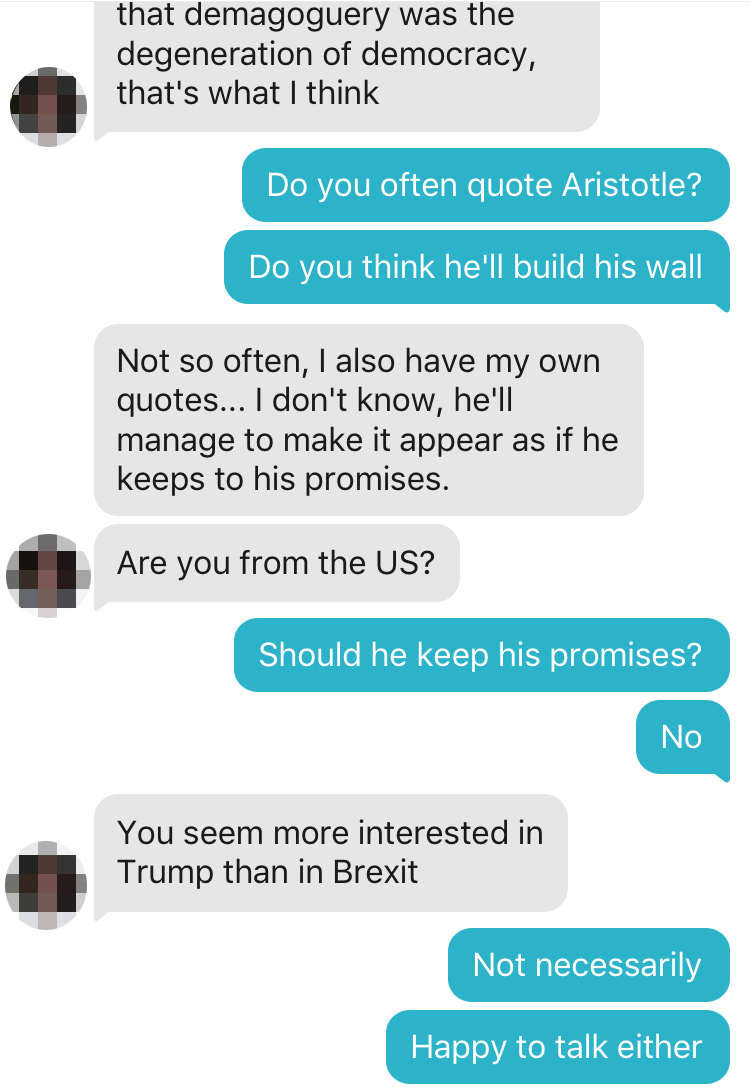

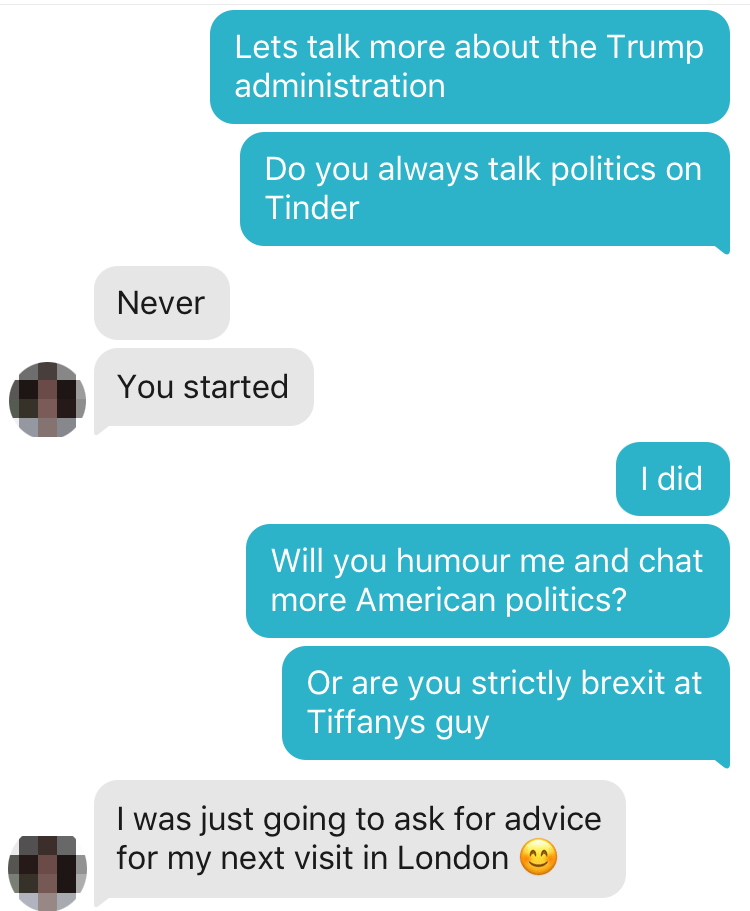


MATCH TWO
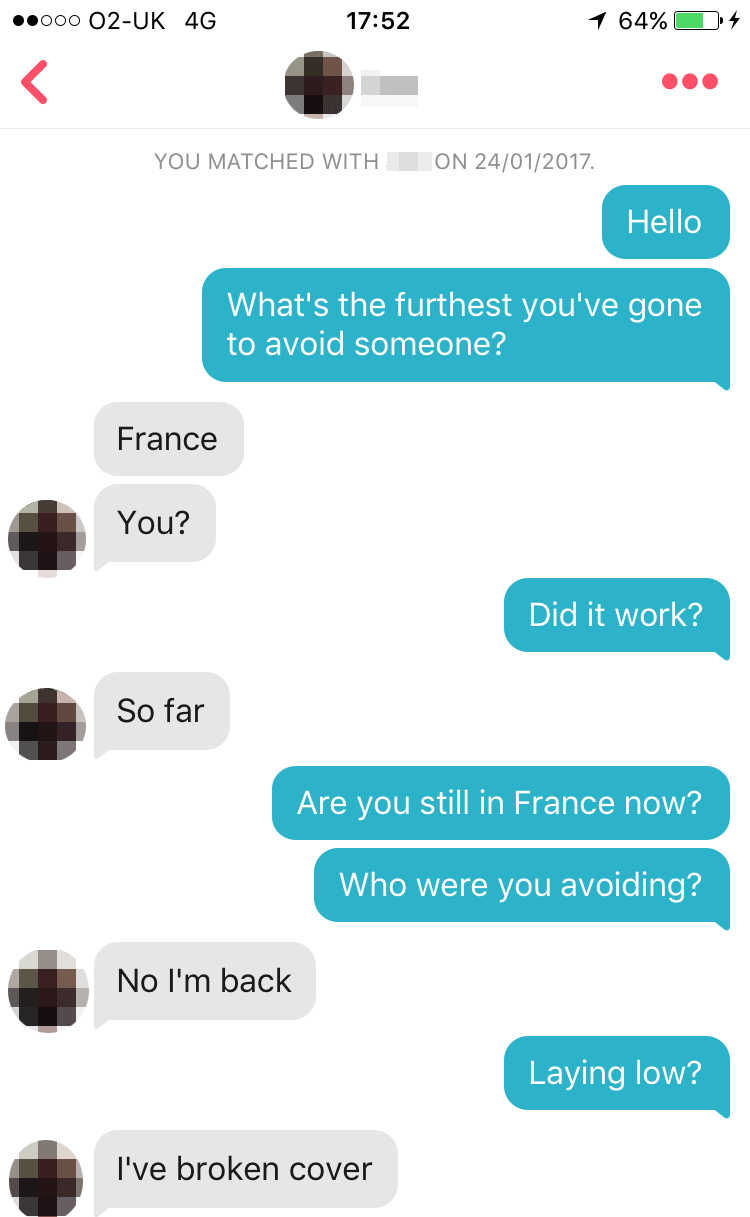



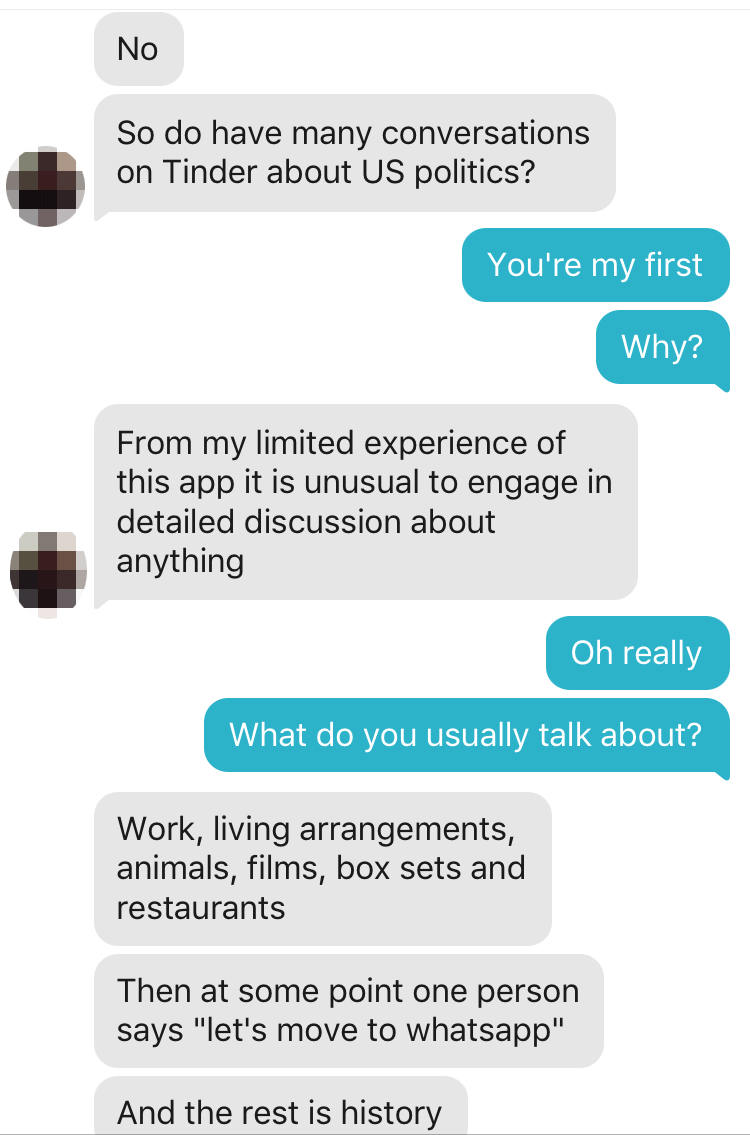
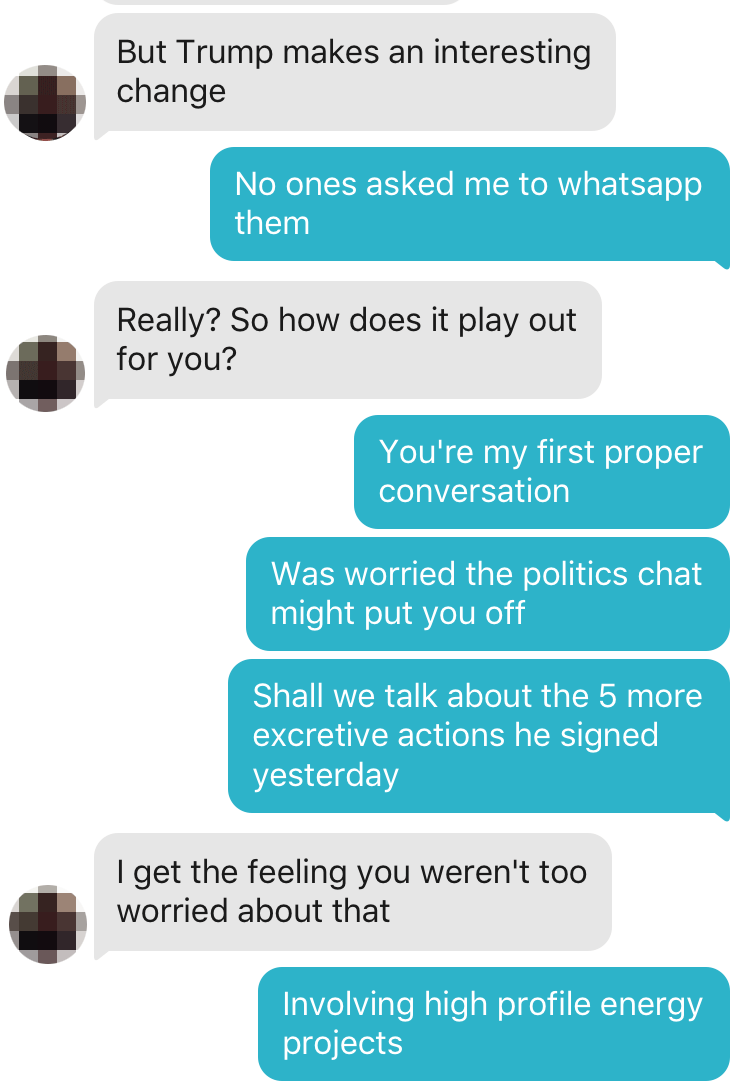
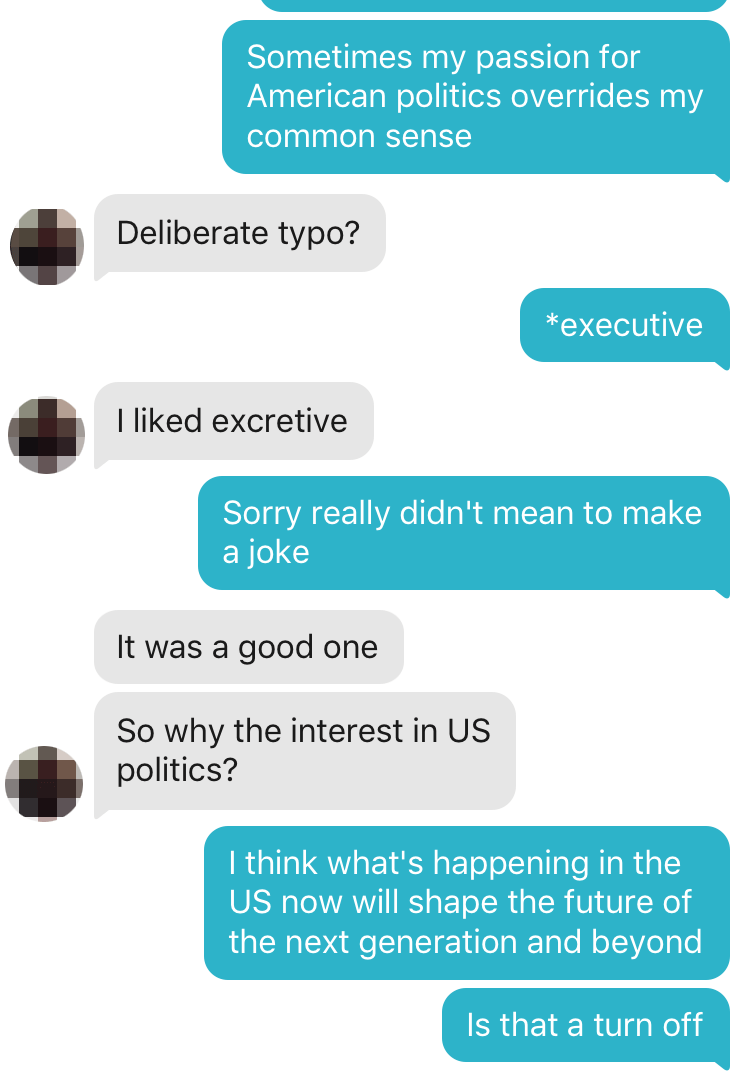
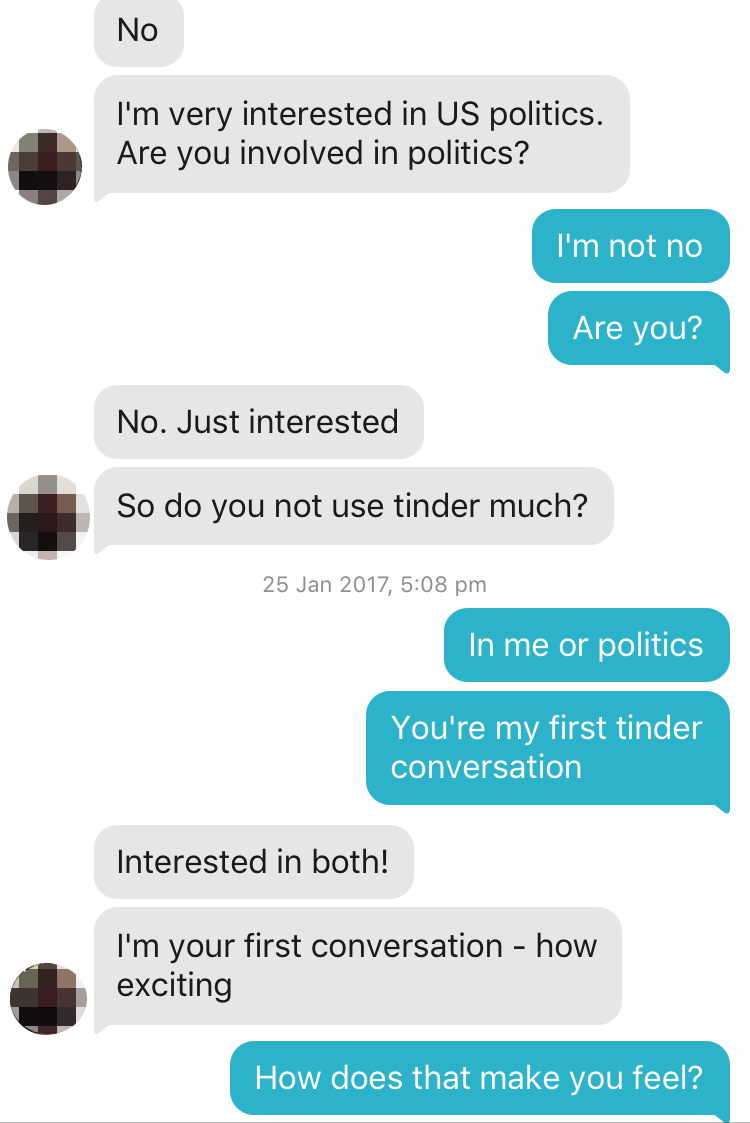
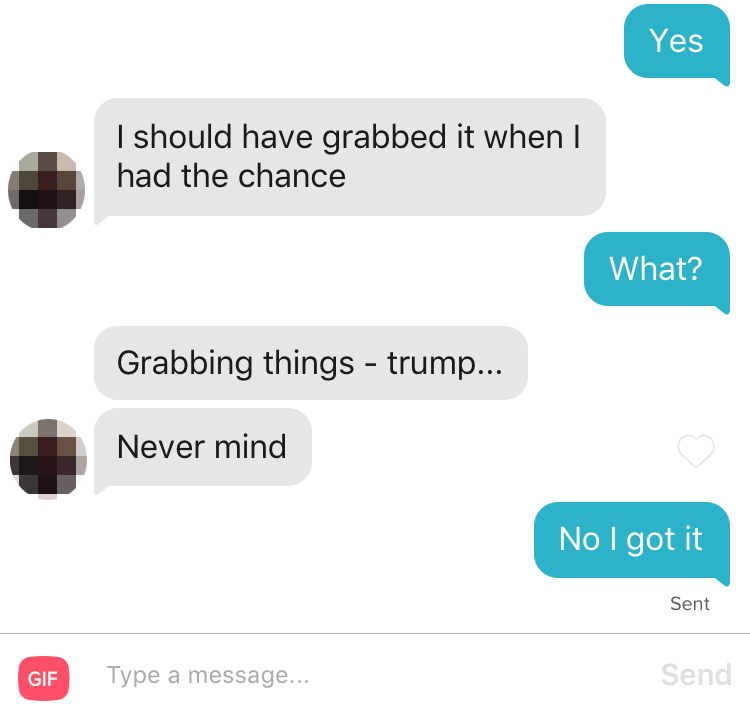

MATCH THREE
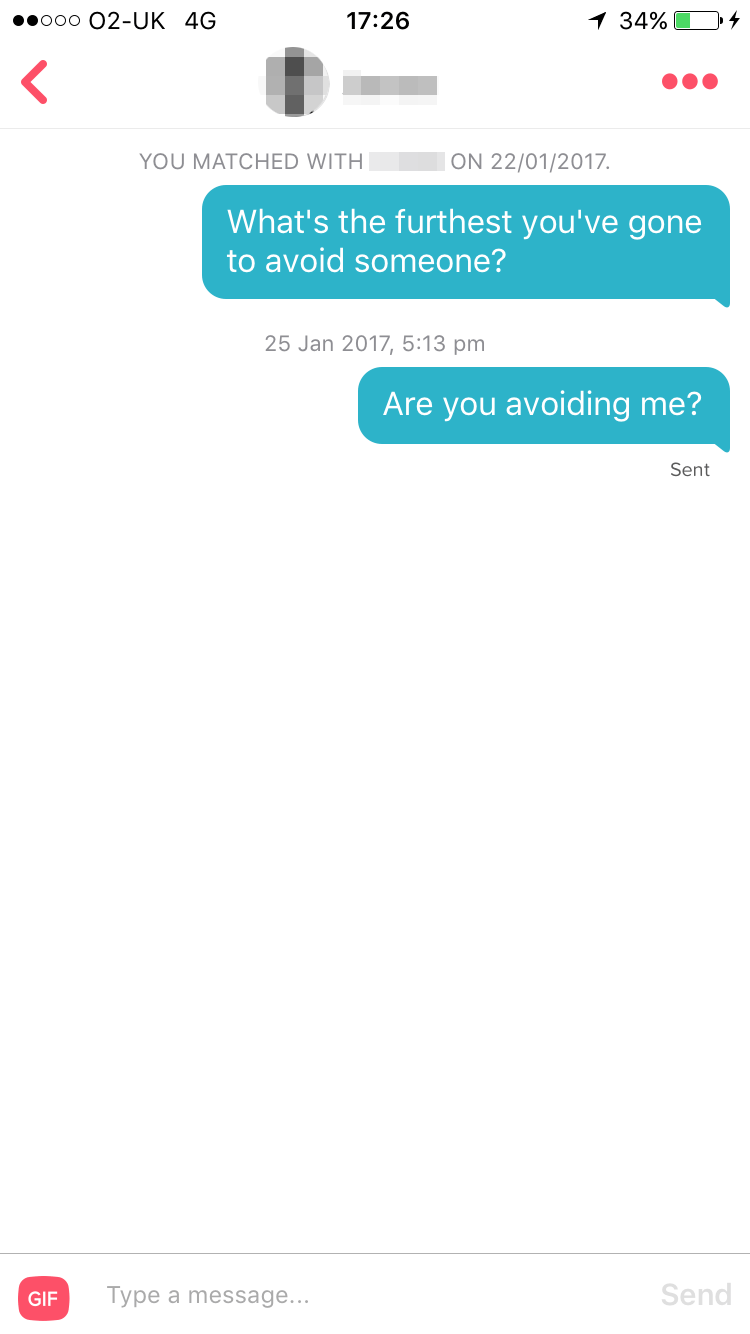
MATCH FOUR


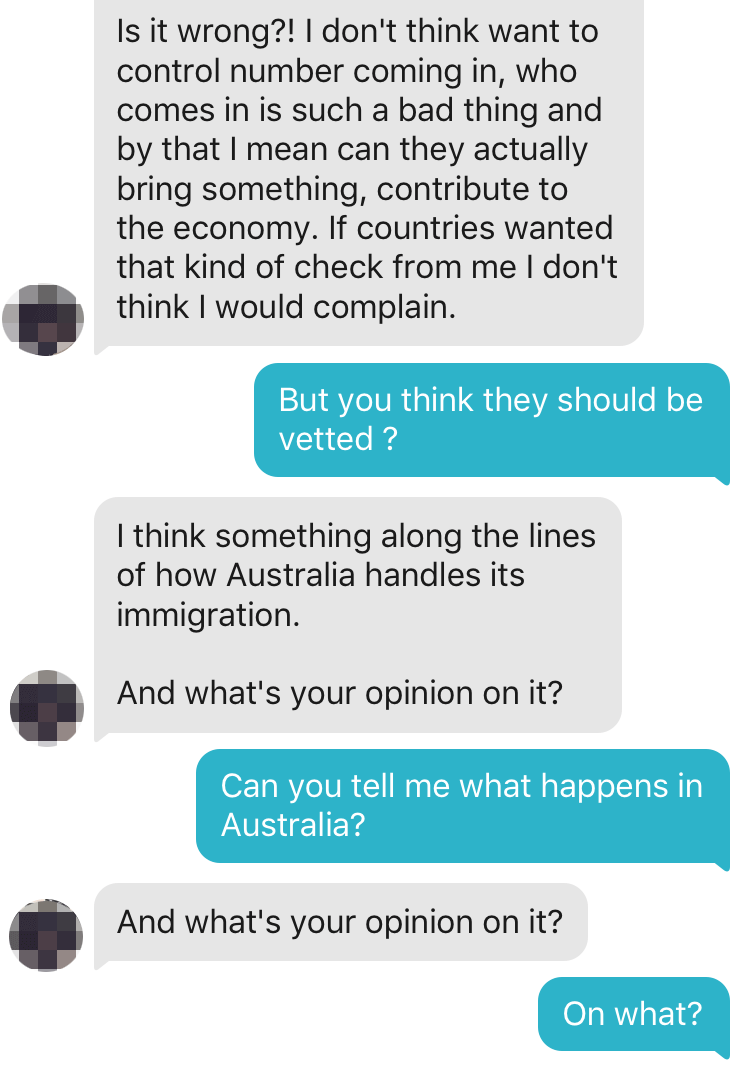

The Rise of the Vegan Bro
Late last year, a video emerged online of a woman who called herself the The Vegan Swearing Grandma. Resplendent half-moon spectacles and fetching silver perm, the pension-aged host claimed to make her own seitan because she had "no time for weak-ass bullshit." She called meat-eaters "simple douchebags" and referred to her marinade as "the tits."
Of course, the video wasn't actually uploaded by a foul-mouthed grandmother, but part of an ongoing Christmas campaign from PETA. The organisation urged viewers to share its message with friends and "let them know that there's nothing festive about eating fucking corpses."
Nevertheless, Vegan Swearing Grandma went viral in certain vegan circles—evidence of a rhetoric that has recently infiltrated the movement: the frat bro.
Read the rest of this article on Munchies.
Donald Trump’s Least Favorite Warplane Has Finally Been Deployed Overseas
Twenty-four years after it entered development, the US military's stealthy F-35 Joint Strike Fighter has deployed overseas for its first frontline missions.
On Jan. 18, 2017, 10 F-35Bs from Marine Fighter Attack Squadron 121 began landingat a Marine air base in Iwakuni, Japan after a nine-day, multi-leg journey from the squadron's previous base in Yuma, Arizona.
Once settled in, the newly-arrived squadron will be part of US Pacific Command's routine contingency planning for war with China or North Korea. If fighting breaks out in the region, the F-35s could go to war.
But that doesn't mean they'll win. The Joint Strike Fighter suffers serious, ongoing problems that cast doubt on its combat prowess. Especially in the Pacific region.
Since initial development of the new plane began in 1993, the Lockheed Martin-made F-35 has weathered a three-year delay, cost overruns, technical malfunctions and harsh criticism from political leaders. Today a single F-35B—that's the Marines' vertically-launching "jump jet" version of the plane—set US taxpayers back as much as $250 million once you factor in development costs.
That's more than twice the price of a new Boeing F-15 Eagle or F/A-18E/F Super Hornet. It could cost $400 billion to buy all 2,400 F-35s the Pentagon wants.
On Dec. 22, Pres. Donald Trump tweeted about the Joint Strike Fighter's "tremendous cost and cost overruns" and threatened to dump the plane in favor of the Super Hornet.
Read more on Motherboard
Trump's Election May Have Killed 'Slacktivism' for Good
Supporters of reproductive rights, immigration reform, the Affordable Care Act, the United Nations, and a government that actually does something about climate change were all dealt a severe, shocking blow on election day. Since then, however, progressives have been donating to groups like Planned Parenthood at a record clip, and a generation stereotyped as being politically apathetic may have been permanently awakened.
It's long been an article of faith that millennials tend to be "slacktivists" who would rather string 20 tweets together than pen a letter to the editor, who will sign a hundred online petitions but don't know who their senators are. In an age of increasing access to information, we seem to have been, paradoxically, on a trajectory of increasing isolation and alienation from the political process, especially the important functions of local government. But as Donald Trump pursues his radical agenda, more and more people are attempting to push back.
Longtime activist Mikki Halpin was inundated with questions after the election about how best to do that pushing back. "I didn't have time to respond to everyone," she said, so she started the Actionnow newsletter, which offers steps for people to get involved in the political world around them. "I want to see people working to get the lights fixed in subway stations so no one gets assaulted, or working to flip a seat in the state legislature, or demanding accountability from their local precinct," Halpin told me, adding that "local change is key to national change."
There's now a cornucopia of resources available for would-be members of the opposition. Online guides like Fight Trump, 2 Hours a Week, and Five-Minute Resistance—all of which help people find ways to get involved with various anti-Trump causes—are making it easier to direct opposition effectively. In about the same amount of time it might take to compose a scathing tweet, users can read an overview of a bill being proposed in Congress and find a script and a number with which to call their representative. Other sites let users fill out a survey about their location and political interests and suggest local organizations at which they can volunteer. In the age of constant, overwhelming bombardment with information, these organizers are curating civic engagement the way Blue Apron curates meals, helping would-be activists fit "participate in democracy" into their daily schedules.
Miriam Zisook had a background in coding and social justice, but wasn't involved in electoral politics before November 8. After the election, however, she told me, "I just saw a way I could use the technical skills I have to give people the tools to go from anger and outrage to practical activism." She created the website Weekly Resistance, where users can find their congressperson's number along with frequently updated scripts for calling about urgent political issues. Weekly Resistance also allows users to log their calls with a click, and keeps a running tally of calls made—a heartening reminder that your actions are part of a cumulative movement.
"I wanted to find a way for people to make fighting Trump a sustainable part of their schedule," Zisook said, adding that she regularly hears from subscribers who say Weekly Resistance is motivating them to make phone calls they wouldn't have otherwise made.
Why phone calls? Unlike signatures on a Change.org petition—or tweets or Facebook comments—a phone call can't be scrolled past; when you call your representative or senator, a staffer has to take the time to speak to you and write down your comments (or copies down what you say in your voicemail). A day of sustained phone calls from an outraged public played a big role in convincing congressional Republicans not to declaw the Office of Congressional Ethics.
For a generation of phone-phobic Americans who haven't spoken into a telephone since we came up with apps for ordering pizza, "call your representative" is a small task that can sound daunting. Social media in the weeks after the election was flooded with posts from users desperate to make their voices heard but stymied by the anxiety of actually calling. (I was one of them; I have intense phone anxiety, and after my first phone call to my senator I had to cry into a cup of tea for a few minutes.) This is what Zisook and organizers like her hope to change—to normalize two-way communication between representatives and their constituents.
Beyond phone calls, organizers can spread the word about local meetings, rally support for postcard and letter campaigns, and, of course, solicit donations for progressive causes. Weekly Resistance suggests a different POC-run organization to donate to every week. The organizers of the Women's March on Washington have begun a "10 Actions in 100 Days" campaign to take advantage of the momentum of the inauguration weekend protests, beginning with a flood of postcards to senators. Outrage is plentiful; the challenge now is to make it politically useful, both now and for future elections.
Amelia Miazad and Kara Ganter, co-founders of Wall-of-us, email their subscribers four weekly acts of resistance that can range from phone calls to meeting with elected officials to taking time for self-care. Ganter, originally from rural Wisconsin, says her goal is to remove barriers and counteract the assumption that activism is only for the educated and well-to-do. "I would love to create tools and avenues for more people to be heard," she told, "and to gain confidence in speaking their truth."
"We want to make activism joyful, and contagious," Miazad added. We want to make it irresistible to resist hateful policies."
Follow Lindsay King-Miller on Twitter.
I Talked to the Artist Who Sold Me a $150 Mystery Box Full of Weird Junk
Two years ago I came across Mark DeLong's Instagram account. At the time he was posting photos of his paintings along with homemade videos, found and candid photos, and ephemera that generally adhered to his unique wit. Mark was also occasionally posting photos of mystery boxes that he was selling for $150. I decided to buy one of these boxes, and I can remember saying to my wife "I wonder if he'll send me one of his ceramic pieces?" He did not. When I opened the box I found: one autographed, expired Cliff bar; one patch of a smiling worm emerging from an apple; three stink bombs; one empty almond and coconut bar wrapper; one altered Fabricland club card made out in my name; six Burger King coupons—each autographed and numbered as multiples. It was a unique experience to feel duped and invited into a joke at the same time. Instantly I became a fan and wanted to know him better, so I invited him to do this interview.
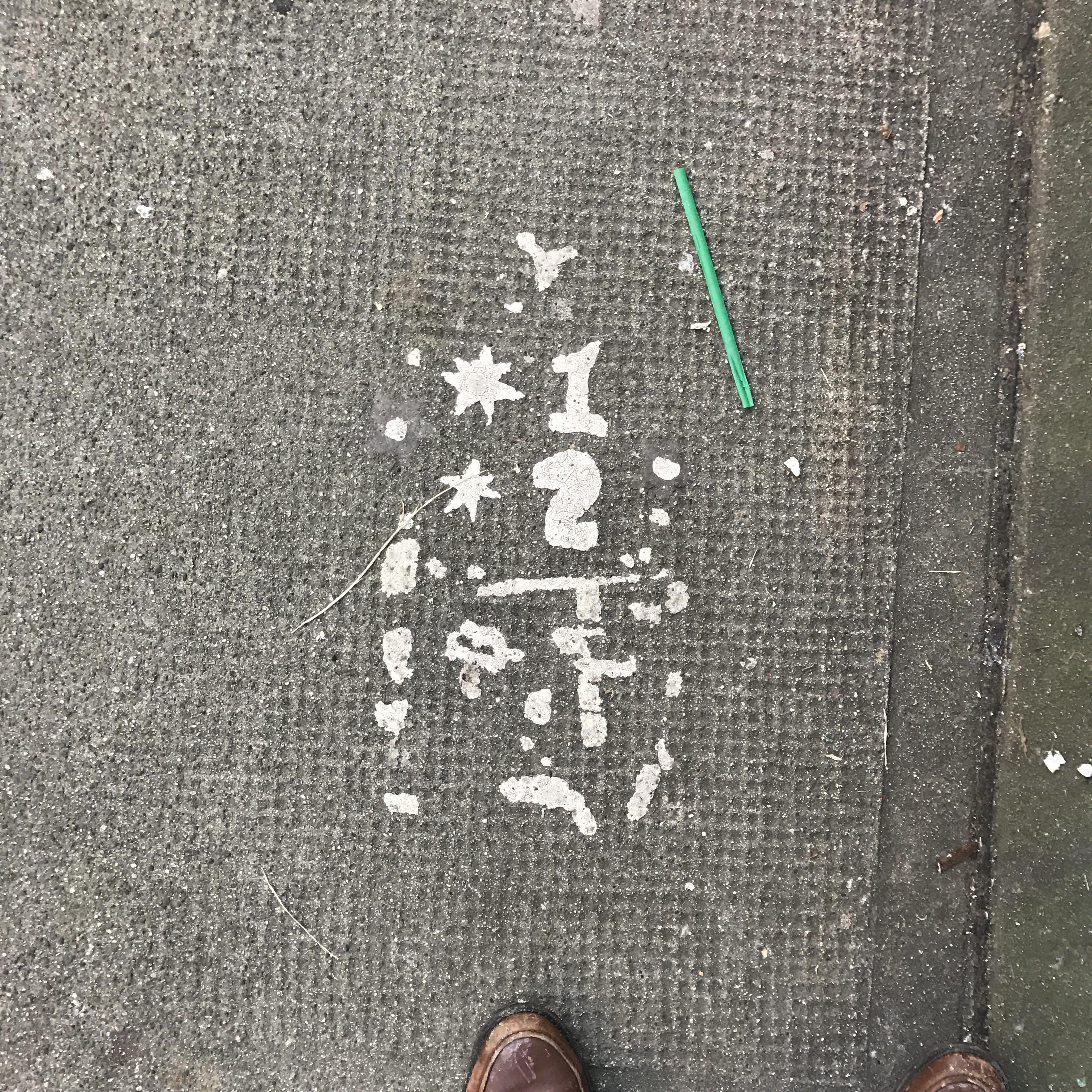
VICE: When did you first start making art?
Mark DeLong: I drew this Frankenstein head pretty well in high school, it filled the whole page—very cool. A guy in my neighbourhood could draw the Megadeth guy, also Iron Maiden's Eddie without tracing. That was magic to me. I drew mostly ghoulish things, couple dragons, I've never been very technically skilled in art making, hooks instead of hands kinda guy, hands in the pockets, everyone standing in puddles. Never got the hang of the figurative or realism. I draw lots of people, rough-looking characters. There was a time where I couldn't bear to draw people because they looked so horrible but eventually settled or maybe got better, new standards. I made little sexy books in elementary school. Naked girls on motorcycles, grabbing their boobs or whatever, popular with the fellas. Wish I still had them but definitely destroyed them. At that same time my friends and I were making fingerboards out of cardboard using cutout graphics from skate mags. I don't actually remember anyone else doing it but myself though, that was a very long time ago. No trucks or wheels just the decks that was a lot of fun—the 80's.
How do you choose your next medium? Your next project?
I've been working on the same for or five things forever, developing and updating. Paintings, gum, textiles, drawing and video. I jump back and forth, picking up where I left off or working through new ideas that crop up in between. Gum has heaps of potential, super exciting but kind of a pain in the ass. I've imagined doing whole cement blocks but I haven't found the time. Better in the summer, winter here now.

I really dig that work. Are you documenting them? I've seen some posted online, but is there more going on than just that?
Yes, quite a few, I take picture with my phone. The gum changes with weather; in the heavy rain they go white and on a hot day all black and then everything in between. The process is like this: soak the gum for a day or two, dry out, roll out, slice it in strips. Place on wax paper, turtle wax it, transfer to sidewalk. Throw some dirt over it and let foot traffic pound it into the ground, or cars or whatever. A new sidewalk on at a busy corner, might last 20 years, that's a pretty good deal. None have been removed yet, so beat that captain spray can. I began with a gum stamper that presses a star shaped design into existing gum spots, works well, not great, looks like a pimp's cane and I almost got into a fight while walking with the cane. A guy almost ran me over in the summer. He didn't think he did, but I said "Easy pal," or something, and he came at me like I was nuts, but I knew I had the cane and how it may have looked. Can't win 'em all I guess.
I have this book called Souls Grown Deep about self-taught artists in the South, and I was looking at it this morning before talking to you. There's an artist named Eldren Bailey, and he had these cement symbols he built into the ground around his house, and they were like the different signs for playing card suits. It reminded me a lot of your gum stamps and some of the large tapestries you've made. I guess this is a really round about way of asking if you view yourself as an outsider in the art world? Where do you see your work?
I don't feel qualified to answer, but I'll give it a whirl. I'm self-taught but art making can't be taught directly anyway, right? Unless you're in some sort of collective situation, so where does that leave off, magic?
Art can't be taught, that's the carriage before the horse situation. Art becomes art when it's successful on all fronts, making art out of thin air, the canvas being the fly in the ointment for the painter. That's extreme but it's true in the sense that actual life is what strives for efficiency more than anything else in this world. The canvas as a vehicle for offerings; conclusions, OSAMA, exercise, habit, whatever, the canvas has this "hey whats on your mind" style of working and it's getting old just like the tortured looney bin artists that adds such value to outsider art. There's an art scene outside of the contemporary and it's just as rich and alive. Old grannies knitting, or even braiding garlic to exaggerate, it's the intent that counts, the rest is just fluff.

Who are some of your influences and who would you recommend looking at today?
I like a little bit of everything, mostly TV shows, M*A*S*H, Only Fools and Horses, Deadwood, and Black Books. I live off that stuff. Art wise, Brian Bellot, Jesse Greenberg, and his resin work, I love resin. Jamien Juliano-Villani, wonderful painter. Joe Bradley, Joe Grillo, Andy Warhol, Brent Butt, Joey Haley, Jason Mclean. I like music too, a real jazz hound and rock, punk rock too.
When you're choosing to try something new are you drawn to stuff that you can finish quickly and move on?
Sometimes, it depends on the time I have. I don't mind spending 12 hours even 24 hours making one thing, but I prefer it to be done in 24 max. Working ceramics can take weeks. It's not that I dislike that long process, but the quicker the results come in the faster you learn how to do whatever it is that you're doing better. If you shot a three pointer and it took two weeks to get there, where would the game be today?
There's this idea of labour being involved. I watched a documentary on Julia Louis-Dreyfus' father —Elaine from Seinfeld . Apparently he was a big art collector and was really drawn to art works that he said were really worked on. He had this labour aesthetic and saw value in that.
I love Elaine. Time spent making never equals quality or originality or anything really. Intent, integrity and attitude rule the art world.
Too much time and too much money?
Too much time and too much money.
Mark DeLong's work will be published in a book by & Pens Press in the spring.
How Solitary Confinement Haunts Me, Five Years After My Release
As soon as I walked in the room, I burst out crying.
The place was shockingly white—neon white. And so small. There was no clock, and no books besides a Bible. The window was too high to see out of. And it was freezing.
Before my first stay in solitary confinement, I didn't think "the hole" sounded all that bad. I like spending time alone—I thought I'd just read quietly and maybe even enjoy the break from human interaction. But I quickly found out that solitary confinement felt a lot less like spending time alone and a lot more like being buried alive in a bright, white hell.
When I walked out of isolation less than a week later, it felt like I'd been there at least a month. With every step I took away from the cell, I was flooded with relief. I thought the mental agony was over. In some ways, though, it was just beginning.
I landed behind bars in 2010. After nine years battling a drug addiction that began in the depths of depression, I was arrested during my senior year of college with a large amount of heroin. I'd been shooting up daily and selling to support my habit—and generally doing all sorts of things I would come to regret.
During my 21 months in the system, I only ended up in solitary confinement twice, and just for a few days each time. The first time was non-punitive: There just wasn't enough space in my "home" jail, so I got shipped off to another one, where I was put in routine isolation for a few days before being cleared to mingle with the general population. The second time was punitive, the result of what seemed to me like a combination of a dubious accusation and paperwork error.
Both times, I had no idea how long I'd be there. I remember wondering: Will I actually get out? Will they forget about me in here? Meanwhile, I cried. I talked to myself. I banged my head against the wall.
Once, I poured milk on my head just to check that I could still feel things, that I was still alive.
Then I contemplated whether I still wanted to be alive—and whether I could figure out a way to kill myself. Was the corner of that desk sharp enough if I fell on it at the right angle? Could I shove a noose through the vent?
The second stay I handled a little better than the first. But they were both some of the worst days of my life. And after all the highly questionable to downright awful things I did during nine years of addiction, that's really saying something.
When I finally got out of solitary—after what seemed like an eternity—I quickly realized it wasn't really over.
At first, I was just shaky and nervous, afraid of offending the jail gods and landing back in the hole. Eventually, whenever there were new inmates and a chance of getting boarded out and put in solitary, I would pack up all my stuff, ready to go, and then rock back-and-forth, waiting anxiously. I developed rituals to ward off fear of isolation. And eventually, I went to the jail mental health staff about the possibility of anti-anxiety medication.
But at that point, I was still locked up. I assumed that as I moved to the exits of the criminal justice system, things would be better. Instead, I starting having dreams about solitary confinement. Sometimes, I woke up screaming.
Eventually, the nightmares faded, even if the anxiety lingered. It follows me still, though—all day, every day. And sometimes I feel like I left part of me in that cell, the part of me that remembered how to worry and obsess just a little bit less.
Mine is not an entirely abnormal reaction, according to Terry Kupers, the Wright Institute professor and psychiatrist who penned the upcoming book Solitary: The Inside Story of Supermax Isolation and How We Can Abolish It. After exposure to solitary, high anxiety is "one of the most common symptoms," he told me. But the other effects vary from one person to the next.
"It's a little like PTSD," Kupers said. "A lot of people go to war and have traumatic experiences, but only some develop the symptoms of PTSD.
"I would say maybe a quarter of the people have full-blown isolation panic," he continued, referencing a term coined by his colleague, Hans Toch, to describe immediate, intense reactions to solitary.
According to Kupers, other symptoms include anxiety, disordered thinking, difficulty with memory, concentration problems, sleep issues, and anger.
On the other hand, some folks in the criminal justice system still don't seem that bothered by solitary confinement.
Check out James Burns's solitary confinement project.
Regina Hufnagel, a former federal corrections officer who now works with the drug-policy-reform group Law Enforcement Action Partnership, only remembers seeing one inmate in nine years who really "freaked out" in solitary confinement.
"One day he said to me that his pink frilly dust ruffle was doing something," she recalled. Of course, his cell bed didn't have a dust ruffle—and if there was one, it certainly wouldn't have been frilly or pink.
But part of why Hufnagel does not seem to have witnessed a slew of negative effects from solitary confinement may stem from the fact that the facility she worked at "didn't use it that often," she conceded.
"I think there is an overall recognition that putting someone in the hole has detrimental effects," Hufnagel told me, stressing that she still feels it could have value as a disciplinary tool when used appropriately.
Right now, in the United States, at least 65,000 people are in solitary confinement on any given day. But the details of what that means can vary considerably from one facility to the next. VICE recently wrapped up a solitary confinement project where James Burns, a filmmaker who spent time in and out of the criminal justice system as a young man, voluntarily entered into a month of isolation at La Paz County Jail in Arizona. VICE rigged up cameras inside the cell to document it all.
But as harrowing as Burns's ordeal might have seemed to an onlooker, solitary confinement can be even worse. Sometimes, the cells are even more barren. Sometimes, there are no books or paper on hand. Sometimes, solitary lasts for years, rather than days or weeks.
That's not to say Burns somehow had it easy. If he's anything like me, no number of jailhouse privileges or amenities would make that kind of isolation a walk in the park.
And even if they did, it's just the start. There's still life on the outside to deal with.
Follow Keri Blakinger on Twitter.
Five Top Drag Queens Explain How to Be Your Own Best Ally
At a moment when our nation is struggling with fundamental questions about its identity, many of us are seeking transformation (whether political or personal) in our own lives—and no one knows more about transformation than a drag queen.
Queens have a reputation for fashioning themselves into something larger than life, for making themselves heard; if anyone can help us find our voices in difficult times, it's them. With that in mind, I asked drag royalty from across the country to reveal the experiences that helped them step up from so-called baby queens into the forces of nature that they are today, lessons that will resonate with anyone seeking change in 2017. Because in drag, as in life, creating a polished surface is just the beginning.
For Maddelyn Hatter, true transformation begins with finding the guts to work through her failures. "I think my major transformation would be to not fear risk," she said. "You'll only get better at something if you're willing to fuck it up." Sometimes, this philosophy applies to one's look—having the nerve to play with "the angle of your brow, the color of your contour"—but it often goes beyond that. For Hatter, it's about taking risks and developing the confidence to take chances in all parts of your life, and not being afraid to step outside yourself in order to find out what works. "You experiment, change it up always. Once you've found that one common denominator that defines you, hold on to that," she said. "Everything else can switch and change like the passing of time."
Finding self-confidence was also a key step forward for Cynthia Lee Fontaine, who said that her signature giddy humor and infectious laughter weren't always part of her drag persona. "In my first [RuPaul's Drag Race] audition tape, it looks like I'm selling vacuum cleaners in an infomercial that no one is going to watch at 3 AM," she said. "I was trying to be proper and professional, because when I was creating [my drag character] Cynthia, it was very pageant, very elegant, and sophisticated. But I'm really the clown in the family—they invite me to every party just to make them laugh. And I realized that separating Cynthia from my daily personality was a huge mistake."
Sometimes, Fontaine said, growth comes not from changing your personality but from augmenting what you know you already have. "You always try to have a certain outcome for yourself, so you don't realize what you have until you stop, look at yourself in the mirror, and say, Oh my God, I am very funny!" she said. "You should have the signature of your own real personal character on your character as an entertainer. That's going to be your key to success."
But transformation isn't always about augmenting the gifts you already have. Sometimes, Laganja Enstranja told me, it's about identifying and eliminating those traits that are holding you back. "The biggest thing that has made me the queen that I am today is getting sober," she said. "I was definitely wild and out of control before. It was all about the party, and not the art or creating an impactful message." In a 2015 interview with Johnny McGovern, host of the popular drag webseries Hey Qween!, Estranja said that she had spent the prior year getting "blackout drunk" while hosting events, attending RuPaul screenings, and even while waiting at the airport on her way to gigs. Driven by the insecurities that come with television notoriety and fueled by the constant stream of free drinks available while on tour, Estranja lost her way.
"But once I got sober, I found my passion and my voice as an activist," she told me. "Everything really changed for me. I wasn't just mindless entertainment anymore—I became an artist with something to say." Today, Estranja has made herself a visible advocate of medical marijuana reform, appearing on the covers of magazines like Dope poised to discuss the intersection of "gay rights, cannabis, and the pursuit of happiness."
Many queens I spoke with reached a turning point in their careers when they began to look at drag as more than just a pastime or a job. As they discovered better ways to connect with themselves, they were also discovering a deeper connection to their art. Like Estranja, Raja learned to look past the constant party that often accompanies life in drag to see what deeper lessons the craft could teach her. "The eye-opening experience for me was discovering that drag isn't just about the fun parts," she said. "Those are definitely the building blocks, but there's a spiritual base in it for me now. Drag teaches you about finding good balance—masculine and feminine, soft and hard—and looking past the black and white to find those middle areas you haven't really explored before. It's different for everyone, but I just find that I'm tapping into those more complex and spiritual aspects of drag that have been around for thousands of years."
True transformation isn't just about a change in one's persona or looks. It's about both—marrying surface with interior to see where they connect. Miss Fame, who is renowned for her immaculate makeup art, often speaks to that connection, and how creating a new exterior for oneself can spark an internal shift. "We all see ourselves a bit differently when in a look," said Fame. "I like to evoke a feeling with makeup. It's not just a face that carries a look for me, it's creating a vessel to carry an emotion to others, making someone look like and feel whatever it is they need to." Whether or not you're part of the drag world, or even captivated by drag, lessons like that can provide the inspiration we need to move forward at a time when our own best ally is ourselves.
Follow Miz Cracker on Instagram.
Desus and Mero Roast Sean Spicer and Kellyanne Conway
On Wednesday night's Desus & Mero, the Bodega Boys threw proverbial tomatoes at the two masters of "alternative facts"—the White House press secretary, Sean Spicer, and senior advisor Kellyanne Conway.
During a recent press conference, Spicer said that the president met with Martin Luther King Jr.—a man who died in 1968. It seems he forgot that there were multiple MLKs in the family, and continued to fumble through the conference like a bad comic during an open-mic night.
Speaking of bad comics bombing on open-mic nights, footage of Kellyanne Conway giving a cringeworthy stand-up performance has also emerged online. And, if you listen closely, you can still hear the crickets from the audience.
Be sure to catch new episodes weeknights at 11:30 PM ET/PT on VICELAND.
Campus Conservatives Are Still Keeping Their Heads Down in the Age of Trump (and Leitch and O’Leary)
The bullshit detector started going off right from the top.
Writing an opinion piece for the CBC, Steven Zhou, a Toronto-based human rights writer, laid out a nightmare vision that was sure to cause a frisson of fear go rippling up the tender spine of readers: The alt-right weren't just in the US voting for Donald Trump and getting yelled at by Shia LaBeouf. They were also in Canada, on our campuses, polluting our kids.
Here's Zhou:
"It may be true that the right wing in Canada has yet to cough up the same kind of populist threat now arising in European liberal democracies like France, Germany or the Netherlands. But the success of president-elect Donald Trump has emboldened nativist elements of Canadian society just the same.
And nowhere has this been more obvious than on Canadian university campuses."
As proof, Zhou cites the scattering of racist, idiotic posters found in recent months on campuses in Toronto and at McGill, UAlberta and McMaster. The material contained racist, anti-Muslim and anti-gay messages that were quickly torn down, destroyed and publicly denounced.
However, warns Zhou, "it will likely take more than tweets and press releases to stem the growth of such messaging on campuses."
Alarming, isn't it?
But for all his dire warnings, Zhou doesn't offer any kind of evidence that the alt-right is in fact growing anywhere, on Canada's campuses or off of them. The fact that those flyers could have been distributed by a single neckbeard with a beef doesn't seem to have entered his mind.
It's the kind of thing that makes Adam Wilson's eyes do somersaults into the back of his head.
I met the president of the Conservative Association at McGill University to figure out just where campus conservatives—a rare and elusive group at the best of times—stand in the age of Trump, the alt-right and the sudden near-respectability of white nationalism.
Not surprisingly, most them are wary of Trump, denounce the policies he espouses and certainly aren't sympathetic to the racists who voted for him. They've heard of the alt-right of course, but haven't seen any of it on campus, they say.
Wilson is an articulate, button-down 21-year-old fourth year BA student originally from Kelowna, BC. He identifies himself as a fiscal, not social, conservative, though he is active in Kellie Leitch's campaign, which has been accused of courting the alt-right. Wilson says he is used to keeping his head down most of the time but he says that's been harder in recent months and years as opinions become more extreme—especially, he says, on the left, which he believes has been quick to shout down dissenting opinion.
But he's no Trump supporter. "I think it's worrying that someone with a lot of reason why you shouldn't vote for him will still get elected," he says. "But a lot of people on campus now are worried about right-wing politics, and they associate all right-wing politics—meaning conservative politics or anything remotely right-leaning—with Donald Trump. And I think that's diminishing people's willingness to listen to right-leaning opinions."
He doesn't think Trump-ism can succeed here, but his imitators, especially fellow blowhard businessman/reality TV personality Kevin O'Leary, leave Wilson unenthused. "It is worrying for me when people who have never held public office want to seek public office," he says. "They only want to be [in politics] if they're in charge…. They're not in it for the country."
He won't lump Leitch into that group, though. According to Wilson, her message has been wildly distorted in the media and by her critics, although her own campaign manager makes it difficult not to make a Trump comparison.
Just as at McGill, wariness of Trump is common among the student Conservative clubs at the Université de Montréal and Concordia. (A request for an interview with a representative from the University of Toronto Campus Conservatives went unanswered and an interview scheduled with the UAlberta Conservative Association was abruptly cancelled at the last minute.) At all three universities, club executives, while acknowledging there are Trump supporters among their membership, were quick to point out that the issues that Trump capitalized on are unique to the United States—particularly those that thrived on grievances common to white America.
Jean-Philippe Fournier from Conservateurs UdeM says the Trump effect was and remains marginal in Canadian conservative circles, particularly in university clubs in Quebec—something he personally is relieved by. He says he and other young conservatives watched Trump's rise like everyone else: as entertainment. But now that he's installed in the White House, he says, "It will have real repercussions for our country in terms of trade, and that's a bit worrying." Fournier, however, is more willing to give someone like Kevin O'Leary a chance, mainly because his position on free trade is the polar opposite of Trump's.
Members of Conservative Concordia, meanwhile, say they are quietly optimistic about the prospects of a Trump presidency, mostly in terms of trade. That doesn't mean they are ready to party about it though.
"We're a very left-wing campus," says Conservative Concordia VP of Events Maria Yordanova. "So being a conservative is not something we advertise, and sometimes it is not very welcome."
Still, says CC president David Dunleavy, there is a clear line between Trumpism and the conservative movement. He says Canada's conservatives have a record of fiscal responsibility and moderation on social issues (though some would argue that). "We disassociate ourselves from [the Trump] movement. And we're not seeing a rise in Trump-style politics in Canada."
Since Zhou's article came out, things have been fairly quiet on the campus alt-right front. No one has come forward to claim responsibility for the flyers (although an alt-right Montreal Facebook page suggests that it was responsible for the McGill incident). There haven't been any alt-right campus clubs organized, or white student unions. If there is a growing movement, it is decidedly underground and invisible.
If Zhou is right and there has been an "emboldening populist wave following the election of Trump" on Canadian campuses, it doesn't seem to have gone much further than a wave of emboldened jerkoffs who've been thrown into the spotlight by a frightened media.
Follow Patrick Lejtenyi on Twitter.
